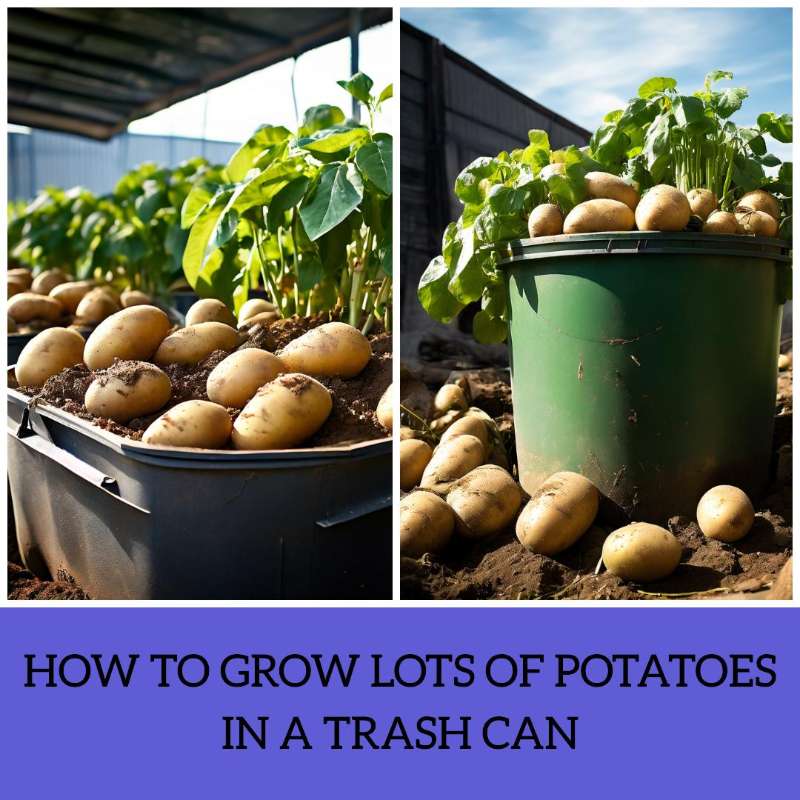How To Grow Lots Of Potatoes In A Trash Can

Make sure to like Living Green and Frugally on Facebook, Shop at Amazon to help support my site and explore our PINTEREST BOARDS for innovative ways you can become self-sufficient.
In the world of gardening, innovation knows no bounds. Whether you have a sprawling backyard or a tiny apartment balcony, there’s always a way to cultivate your green thumb.
If you’re looking for a fun, space-saving method to grow potatoes, why not try using a trash can? It’s unconventional yet surprisingly effective. Here’s how you can grow plenty of potatoes in a simple garbage can.
View this post on Instagram
Choosing the Right Trash Can
First things first, you’ll need a suitable container. Opt for a new garbage can or ensure that any used one you select is thoroughly cleaned. Drill several drainage holes—about half an inch in diameter—in the bottom and sides near the base of the can. Proper drainage is essential for healthy potato growth.
Preparing the Container
To prevent soil from escaping through the drainage holes and to maintain moisture, start by layering the bottom of the garbage can with shredded newspaper or old junk mail. This acts as a barrier while keeping the soil moist.
Next, fill the can with approximately six inches of high-quality potting soil. If desired, mix in some fertilizer for added nutrients. A recommended mixture is the “square foot gardening” blend, comprising one-third peat moss, one-third compost, and one-third asbestos-free vermiculite.
Planting the Potatoes
Cut your seed potatoes into pieces, ensuring each piece has several eyes. Alternatively, you can use store-bought potatoes, though results may vary.
Plant these potato pieces in the soil, spacing them several inches apart. Cover the seeds with approximately one inch of soil and water thoroughly.
View this post on Instagram
Caring for Your Potatoes
As the potato plants begin to sprout, maintain their growth by adding compost, soil, or straw to the garbage can. Continue this process as the vines grow, ensuring they are covered except for the top inch.
It’s crucial to keep the soil consistently moist but not waterlogged. Monitor the moisture levels closely to avoid drying out or saturating the soil.
Layering Technique:
- Bottom Layer: Start by placing a layer of shredded newspaper or junk mail at the bottom of the trash can. This acts as a barrier to prevent soil from escaping while retaining moisture. The layer should be thick enough to cover the entire bottom surface of the can.
- First Soil Layer: Add a layer of potting soil on top of the newspaper, filling the can to a depth of about six inches. This serves as the initial planting bed for the seed potatoes.
- Planting Potatoes: Place the seed potatoes or potato pieces evenly spaced within the first soil layer. Ensure that each potato piece has sufficient space to grow and spread its roots. Aim for a spacing of several inches between each seed potato to prevent overcrowding.
- Covering Potatoes: Once the potatoes are in place, cover them with another layer of soil, approximately one inch thick. This layer provides additional support and protection for the growing potatoes.
- Subsequent Layers: As the potato plants grow, continue to add layers of soil, compost, or straw to the trash can, covering all but the top inch of the vines. Repeat this process periodically as the plants develop, allowing them to grow upward within the confines of the container.
View this post on Instagram
Spacing and Staking:
- Vertical Growth: Potatoes have the unique ability to produce tubers along the length of their stems. By allowing the vines to grow vertically within the trash can, you can maximize the available space and increase the yield of potatoes.
- Staking: If necessary, use stakes or trellises to support the growing vines as they extend beyond the top of the trash can. This helps prevent the plants from sprawling and ensures that they remain upright, maximizing the use of vertical space.
Watering and Maintenance:
- Consistent Moisture: Maintain consistent moisture levels in the soil throughout the growing season. Water the potatoes regularly, ensuring that the soil is evenly moist but not waterlogged. Monitor the moisture levels closely, especially during hot or dry weather, to prevent the soil from drying out.
- Fertilization: Consider supplementing the soil with organic fertilizer or compost to provide essential nutrients for optimal potato growth. Apply fertilizer according to package instructions, taking care not to over-fertilize, which can lead to excessive foliage growth at the expense of tuber development.
View this post on Instagram
Harvesting:
- Selective Harvesting: When harvesting potatoes, you can selectively dig out “new potatoes” while the vines are still alive and continue to harvest larger potatoes as the plants mature. This staggered approach allows you to enjoy fresh potatoes throughout the growing season while maximizing overall yield.
Harvesting Your Bounty
Once the vines reach about four inches in height, you’ll notice them flowering. Soon after, potatoes will start to form along the length of the vines. You can gently dig into the soil to retrieve “new potatoes” while the vines are still alive. These freshly harvested potatoes are incredibly flavorful but don’t store well, so be sure to enjoy them promptly.
As the potato plants mature and the flowers fade, your larger potatoes will be ready for harvest. When the stalks turn yellow, it’s a sign that your crop is ripe for picking. With proper care, you can expect an impressive yield of up to 40 pounds or more from a single season’s growth.
Conclusion, Growing potatoes in a trash can is not only a space-saving solution but also a rewarding gardening experience. With just a few simple steps and minimal space requirements, you can cultivate a bountiful harvest of delicious potatoes right on your doorstep. So, why not give it a try? Embrace the creativity of gardening and enjoy the satisfaction of growing your own food, one potato at a time.